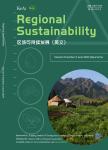Sustainable livelihood security in Odisha, India: A district level analysis
Sustainable livelihood security in Odisha, India: A district level analysis作者机构:Department of EconomicsBerhampur UniversityOdisha760007India
出 版 物:《Regional Sustainability》 (区域可持续发展(英文))
年 卷 期:2022年第3卷第2期
页 面:110-121页
学科分类:02[经济学] 0830[工学-环境科学与工程(可授工学、理学、农学学位)] 0201[经济学-理论经济学] 020105[经济学-世界经济]
主 题:Sustainable livelihood security Ecological security index Social equity index Economic efficiency index Odisha Principal component analysis
摘 要:Sustainable livelihood security(SLS) is an integrating framework that encompasses current concerns and policy requirements for ecological, social, and economic dimensions of sustainable development. It carries particular importance for developing economies. This study intends to verify the relative status of SLS of the 30 districts in Odisha, which is a backward state in eastern India. In this study, a total of 22 relevant indicators relating to the three components of SLS—ecological security, social equity, and economic efficiency have been taken, based on various kinds of government reports. The principal component analysis(PCA) was used to ascertain the indicators and the importance of each of them to the corresponding component of SLS. The ecological security index(ESI), social equity index(SEI), economic efficiency index(EEI), and composite sustainable livelihood security index(CSLSI) of each district of Odisha were calculated through the min-max normalization technique. The results revealed that there are wide variations in SLS among the districts of Odisha. In this study, the districts are categorized into four levels based on the scores of ESI, SEI, EEI, and CSLSI as very low(0.700). According to the classification result of CSLSI, 2 districts are found to be in the very low category, 20 districts are under the low sustainability category, 8 districts are in the medium category, and none of the districts are found to be in the high sustainability category. The district of Sambalpur ranks the highest with a CSLSI score of 0.624. The bottom five districts are Gajapati, Bolangir, Nabarangpur, Kandhamal, and Malkangiri, having the CSLSI scores of 0.438, 0.435, 0.406, 0.391, and 0.344, respectively. The result of this study suggests that region-specific, systematic, and proactive approaches are desirable for balanced development in Odisha. Further, policy intervention is required to implement more inclusiv



